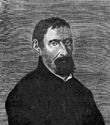1624
| Millennium: | 2nd millennium |
|---|---|
| Centuries: |
|
| Decades: | |
| Years: |
|
| 1624 by topic |
|---|
| Arts and science |
|
| Leaders |
|
| Birth and death categories |
| Births – Deaths |
| Establishments and disestablishments categories |
| Establishments – Disestablishments |
| Works category |
|
| Gregorian calendar | 1624 MDCXXIV |
| Ab urbe condita | 2377 |
| Armenian calendar | 1073 ԹՎ ՌՀԳ |
| Assyrian calendar | 6374 |
| Balinese saka calendar | 1545–1546 |
| Bengali calendar | 1031 |
| Berber calendar | 2574 |
| English Regnal year | 21 Ja. 1 – 22 Ja. 1 |
| Buddhist calendar | 2168 |
| Burmese calendar | 986 |
| Byzantine calendar | 7132–7133 |
| Chinese calendar | 癸亥年 (Water Pig) 4320 or 4260 — to — 甲子年 (Wood Rat) 4321 or 4261 |
| Coptic calendar | 1340–1341 |
| Discordian calendar | 2790 |
| Ethiopian calendar | 1616–1617 |
| Hebrew calendar | 5384–5385 |
| Hindu calendars | |
| - Vikram Samvat | 1680–1681 |
| - Shaka Samvat | 1545–1546 |
| - Kali Yuga | 4724–4725 |
| Holocene calendar | 11624 |
| Igbo calendar | 624–625 |
| Iranian calendar | 1002–1003 |
| Islamic calendar | 1033–1034 |
| Japanese calendar | Genna 10 / Kan'ei 1 (寛永元年) |
| Javanese calendar | 1545–1546 |
| Julian calendar | Gregorian minus 10 days |
| Korean calendar | 3957 |
| Minguo calendar | 288 before ROC 民前288年 |
| Nanakshahi calendar | 156 |
| Thai solar calendar | 2166–2167 |
| Tibetan calendar | 阴水猪年 (female Water-Pig) 1750 or 1369 or 597 — to — 阳木鼠年 (male Wood-Rat) 1751 or 1370 or 598 |

1624 (MDCXXIV) was a leap year starting on Monday of the Gregorian calendar and a leap year starting on Thursday of the Julian calendar, the 1624th year of the Common Era (CE) and Anno Domini (AD) designations, the 624th year of the 2nd millennium, the 24th year of the 17th century, and the 5th year of the 1620s decade. As of the start of 1624, the Gregorian calendar was 10 days ahead of the Julian calendar, which remained in localized use until 1923.
Events[]
January–June[]
- January 14 – After 90 years of Ottoman occupation, the Safavid Empire recaptures Baghdad.
- January 24 – Afonso Mendes, appointed by Pope Gregory XV as Prelate of Ethiopia, arrives at Massawa from Goa.
- April 15 – The University of Saint Francis Xavier is founded in Bolivia.
- April 29 – Louis XIII of France appoints Cardinal Richelieu to the Conseil du Roi (Royal Council).
- May 8 – Capture of Bahia: A Dutch West India Company fleet captures the Brazilian city of Salvador, Bahia from the Portuguese Empire (at this time in the Iberian Union).
- May 24
- The city of Oslo, Norway, is destroyed by fire for the fourteenth time.[1] King Christian IV of Denmark–Norway decrees its rebuilding on a new site, where it will be renamed Christiania.
- After years of unprofitable operation, Virginia's charter is revoked, and it becomes a royal colony.
- May 25 – The Scottish city of Dunfermline is destroyed by fire, but The Abbey, The Palace, the Abbot House and many other buildings survive.
- June – The first Dutch settlers arrive in New Netherland; they disembark at Governors Island.
- June 10 – Treaty of Compiègne is signed between the Kingdom of France and the Dutch Republic.[2]
July–December[]
- July or August – Portuguese Jesuit priest António de Andrade becomes the first European to enter Tibet.
- August
- The Siege of Breda begins, and will continue for 10 months.
- Chinese admiral Yu Zigao forces the Dutch East India Company to withdraw from their post at Penghu, to Fort Zeelandia (Taiwan).
- August 5–14 – The King's Men perform Thomas Middleton's satire A Game at Chess at the Globe Theatre, London, until it is suppressed in view of its allusions to the Spanish Match.[3]
- August 13 – Cardinal Richelieu is appointed by Louis XIII of France to be his chief minister, having intrigued against Charles de La Vieuville, Superintendent of Finances, arrested for corruption the previous day.
- October 3 – A combined squadron of fifteen Neapolitan (Spain), Tuscan, and Papal galleys defeat a squadron of six Algerian ships on the island of San Pietro, near Sardinia. (details)
- December 24 – Denmark's first postal service is launched by order of King Christian IV.
Date unknown[]
- The Palace of Versailles is first built by Louis XIII, as a hunting lodge.
- The Japanese shōgun expels the Spanish from the land, and severs trade with the Philippines.
- Henry Briggs publishes Arithmetica Logarithmica.[4]
- Jakob Bartsch first publishes a chart, showing the constellation Camelopardalis around the North Star.
- The French Parlement passes a decree forbidding criticism of Aristotle, on pain of death.[5]
- Queen Nzinga of Ndongo and Matamba starts to rule.
- The Latymer School and Latymer Upper School in London are founded, by the bequest of Edward Latymer.
- Frans Hals produces the painting later known as the Laughing Cavalier.[6]
- The German-language Luther Bible is publicly burned, by order of the Pope.
Births[]

Guarino Guarini

Pierre Lambert de la Motte

Lambert Doomer

Thomas Sydenham

Murad Bakhsh

Barent Fabritius
January–March[]
- January 7 – Guarino Guarini, Italian architect of the Piedmontese Baroque (d. 1683)
- January 9 – Empress Meishō of Japan (d. 1696)
- January 15 – Rombout Verhulst, Dutch sculptor (d. 1698)
- January 16 – Pierre Lambert de la Motte, French bishop (d. 1679)
- January 18 – Thyrsus González de Santalla, Spanish theologian elected Superior General of the Society of Jesus (d. 1705)
- January 26 – George William, Duke of Brunswick-Lüneburg (d. 1705)
- January 31 – Arnold Geulincx, Flemish philosopher (d. 1669)
- February 11
- Ivan Ančić, Croatian theological writer (d. 1685)
- Lambert Doomer, Dutch Golden Age landscape painter (d. 1700)
- February 23 – Robert Treat, American colonial leader (d. 1710)
- March – Jane Leade, English esotericist (d. 1704)
- March 6 – Johann Georg Albinus, German pastor and hymnist (d. 1679)
- March 12 – Damian Hartard von der Leyen-Hohengeroldseck, German archbishop (d. 1678)
- March 20 – William Jones, English lawyer, Deputy Governor of Connecticut (d. 1706)
- March 21
- François Roberday, French Baroque organist and composer (d. 1680)
- Paolo Segneri, Italian Jesuit (d. 1694)
- March 25 – William Pulteney, English Member of Parliament (d. 1691)
- March 31 – Antoine Pagi, French ecclesiastical historian (d. 1699)
April–June[]
- April 4 – François Marie, Prince of Lillebonne, French nobleman and member of the House of Lorraine (d. 1694)
- April 9 – Henrik Rysensteen, Dutch military engineer (d. 1679)
- April 12 – Charles Amadeus, Duke of Nemours (d. 1652)
- April 15 – Pieter Nijs, Dutch Golden Age painter (d. 1681)
- April 20 – Samuel Mearne, English Restoration bookbinder and publisher (d. 1683)
- April 24 – Jan Peeters I, Flemish Baroque painter (d. 1677)
- April 25 – Sir Lionel Tollemache, 3rd Baronet, English baronet (d. 1669)
- April 26 – Johann Leusden, Dutch Calvinist theologian (d. 1699)
- May 13 – Aleksander Kazimierz Sapieha, Polish nobleman and archbishop (d. 1671)
- May 23 – William Duckett, English politician (d. 1686)
- May 30 – Leopold Frederick, Duke of Württemberg-Montbéliard, German noble (d. 1662)
- June 11 – Jean-Baptiste du Hamel, French cleric and natural philosopher (d. 1706)
- June 15 – Hiob Ludolf, German orientalist (d. 1704)
- June 16 – William Bradford, American political and military leader (d. 1703)
- June 20 – Henry Albin, English minister (d. 1696)
- June 26 – James Scudamore, English politician (d. 1668)
July–September[]
- July – George Fox, English founder of the Quakers (d. 1691)[7]
- July 11 – John Collins, English academic and politician (d. 1711)
- July 18 – Francis Pemberton, English judge, Lord Chief Justice of the King's Bench (d. 1697)
- August 6 – Charles Kerr, 2nd Earl of Ancram, English politician (d. 1690)
- August 11 – John Strode, English politician (d. 1679)
- August 22 – Jean Regnault de Segrais, French poet and novelist born in Caen (d. 1701)
- August 23 – Anna Elisabeth of Saxe-Lauenburg, Landgravine consort of Hesse-Homburg (d. 1688)
- August 24 – Petronella de la Court, Dutch art collector (d. 1707)
- August 25 – François de la Chaise, French churchman (d. 1709)
- August 27 – Koxinga, Chinese military leader (d. 1662)
- September 1 – Simón González de Acosta, Spanish colonial governor (d. 1653)
- September 10 – Thomas Sydenham, English physician (d. 1689)
- September 12 – Wingfield Cromwell, 2nd Earl of Ardglass, English nobleman (d. 1668)
- September 15 – Francesco Provenzale, Italian Baroque composer and teacher (d. 1704)
October–December[]
- October 5 (bapt.) – Gaspar de Witte, Flemish painter (d. 1681)
- October 9 – Murad Bakhsh, Mughal prince (d. 1661)
- October 19 – Robert Danvers, English politician (d. 1674)
- October 20 – Jan Albertsz Rotius, Dutch painter (d. 1666)
- October 21 – Edward Harley, English politician (d. 1700)
- October 26 – Dosoftei, Moldavian Metropolitan (d. 1693)
- October 30 – Paul Pellisson, French author (d. 1693)
- November 2 – Sir Thomas Myddelton, 1st Baronet, English politician (d. 1663)
- November 3 – Jean II d'Estrées, French noble (d. 1707)
- November 16 – Barent Fabritius, Dutch painter (d. 1673)
- November 28 – Angélique de Saint-Jean Arnauld d'Andilly, French Jansenist nun (d. 1684)
- December 16 – Queen Jangnyeol, Korean royal consort (d. 1688)
- December 17 – Juriaen Jacobsze, Dutch painter (d. 1685)
- December 18 – John Hull, merchant and mintmaster of the Massachusetts Bay Colony (d. 1683)
- December 25 – Angelus Silesius, German writer (d. 1677)
Date unknown[]
- Torii Tadaharu, Japanese nobleman (d. 1651)
- Louise de Prie, French royal governess (d. 1709)
Approximate date[]
Deaths[]

Ketevan the Martyr

Willem Pieterszoon Buytewech

Gaspard Bauhin
January–March[]
- January 3 – Jacopo Inghirami, Tuscan admiral (b. 1565)
- January 17 – Tamás Erdődy, Hungarian noble, Ban of Croatia (b. 1558)
- January 24 – Martin Becanus, Belgian Jesuit priest (b. 1563)
- February 4
- Thomas Humphrey, English politician (b. 1554)
- Vicente Espinel, Spanish writer (b. 1550)
- February 6 – Lamoral, 1st Prince of Ligne (b. 1563)
- February 7 – Cort Aslakssøn, Norwegian astronomer (b. 1564)
- February 12 – George Heriot, Scottish goldsmith and philanthropist (b. 1563)
- February 13 – Stephen Gosson, English satirist (b. 1554)
- February 16 – Ludovic Stewart, 2nd Duke of Lennox, Scottish nobleman and politician (b. 1574)
- February 17 – Juan de Mariana, Spanish historian (b. 1536)
- February 18 – Francis Ros, first Latin Archbishop of Angamaly-Cranganore (b. 1559)
- February 19 – Thomas Fleming, English politician (b. 1572)
- February 21 – John Adolph, Duke of Schleswig-Holstein-Sonderburg-Norburg, Duke of Norburg at Als (b. 1576)
- February 24 – Paul Laurentius, German divine (b. 1554)
- February 28 – Clemens Timpler, German philosopher (b. 1563)
- March 15 – Louis of Anhalt-Köthen, German prince (b. 1607)
- March 27 – Ulrik of Denmark, Danish prince-bishop (b. 1578)
- March 28 – Richard Sackville, 3rd Earl of Dorset, English noble (b. 1589)
April–June[]
- April 13 – William Bishop, first Roman Catholic bishop after the English Reformation (b. 1553)
- April 17 – Mariana Navarro de Guevarra Romero, Spanish Catholic nun who became a member of the Mercedarian Tertiaries (b. 1565)
- May 12 – John Rashleigh, English politician (b. 1554)
- May 27 – Diego Ramírez de Arellano, Spanish sailor and cosmographer (b. c. 1580)
- June 2 – Jacques l'Hermite, Dutch admiral and explorer (b. 1582)
- June 4 – Rombertus van Uylenburgh, Dutch lawyer (b. 1554)
July–September[]
- July – Alonso Fajardo de Entenza, governor of the Philippines
- July 17 – Johan van Dorth, Dutch noble (b. 1574)
- July 22 – García de Silva Figueroa, Spanish diplomat and traveller (b. 1550)
- July 31 – Henry II, Duke of Lorraine (b. 1563)
- August 4 – Emanuel Filibert of Savoy, Viceroy of Sicily (b. 1588)
- August 25 – Luis Sotelo, Spanish Franciscan friar (b. 1574)
- September – Marco Antonio de Dominis, Dalmatian archbishop and apostate (b. 1560)
- September 7 – Carew Reynell, English politician (b. 1563)
- September 13 – Ketevan the Martyr, queen of Kakheti (b. c. 1560)
- September 17 – Gilles du Monin, Belgian Jesuit historian (b. 1565)
- September 18 – Pedro Osores de Ulloa, Royal Governor of Chile (b. 1554)
- September 23 – Willem Pieterszoon Buytewech, Dutch Golden Age painter (b. 1592)
- September 25 – Fronton du Duc, French Jesuit theologian (b. 1558)
- September 29 – Simón de Rojas, Spanish saint (b. 1552)
October–December[]
- October 22 – Jessé de Forest, American colonist (b. 1576)
- November 2 – Cornelis van der Voort, Dutch painter (b. 1576)
- November 5 – James Wriothesley, Lord Wriothesley, English politician (b. 1605)
- November 10 – Henry Wriothesley, 3rd Earl of Southampton, English patron of the theatre (b. 1573)
- November 13 – Thomas van Erpe, Dutch Orientialist, cartographer (b. 1584)
- November 14 – Costanzo Antegnati, Italian composer, organist (b. 1549)
- November 15 – Caius of Korea, Japanese martyr (b. 1571)
- November 17 – Jakob Böhme, German mystic (b. 1575)
- December 5 – Gaspard Bauhin, Swiss botanist (b. 1560)
- December 6 – Francesco Contarini, Doge of Venice (b. 1556)
- December 9 – Flaminio Scala, Italian playwright and stage actor (b. 1552)
- December 14 – Charles Howard, 1st Earl of Nottingham, English statesman (b. 1536)
- December 15 – Jerónimo Bautista Lanuza, Spanish friar, bishop and writer (b. 1533)
- December 25
- Hajikano Masatsugu, Japanese samurai (b. 1545)
- Catherine of Nassau-Dillenburg, German noble (b. 1543)
- December 28 – Charles of Austria, Bishop of Wroclaw, Prince-bishop of Wroclaw (b. 1590)
- December 29 – Dermod O'Brien, 5th Baron Inchiquin, Irish baron (b. 1594)
- December 30 – John Kendrick, prosperous English cloth merchant (b. 1573)
Date unknown[]
- Francesco Andreini, Italian actor (b. c. 1548)
References[]
- ^ "Fires, Great", in The Insurance Cyclopeadia: Being an Historical Treasury of Events and Circumstances Connected with the Origin and Progress of Insurance, Cornelius Walford, ed. (C. and E. Layton, 1876) p29
- ^ Richard Bonney (1981). The King's Debts: Finance and Politics in France 1589-1661. Clarendon Press. p. 122. ISBN 978-0-19-822563-8.
- ^ Trevor Howard Howard-Hill (1995). Middleton's "Vulgar Pasquin": Essays on A Game at Chess. University of Delaware Press. p. 156. ISBN 978-0-87413-534-3.
- ^ Professor of History Mordechai Feingold; Mordechai Feingold (February 9, 1984). The Mathematician's Apprenticeship: Science, Universities and Society in England 1560-1640. CUP Archive. p. 141. ISBN 978-0-521-25133-4.
- ^ "Rene Descartes". Encyclopædia Britannica. 2009. Retrieved October 11, 2009.
- ^ Wallace Collection, London.
- ^ Friends' Literature Committee (1971). New Appreciations of George Fox; a Tercentenary Collection of Studies. Kennikat Press. p. 26. ISBN 978-0-8046-1163-3.
- ^ Nielsen, J.; Hedeholm, R. B.; Heinemeier, J.; Bushnell, P. G.; Christiansen, J. S.; Olsen, J.; Ramsey, C. B.; Brill, R. W.; Simon, M.; Steffensen, K. F.; Steffensen, J. F. (August 12, 2016). "Eye lens radiocarbon reveals centuries of longevity in the Greenland shark (Somniosus microcephalus)". Science. 353 (6300): 702–704. doi:10.1126/science.aaf1703. hdl:2022/26597. PMID 27516602. S2CID 206647043.
- ^ Pennisi, Elizabeth (August 11, 2016). "Greenland shark may live 400 years, smashing longevity record". Science. Retrieved August 11, 2016.
- ^ Morelle, Rebecca (August 12, 2016). "400-year-old Greenland shark 'longest-living vertebrate'". BBC News. Retrieved August 12, 2016.
Categories:
- 1624
- Leap years in the Gregorian calendar

